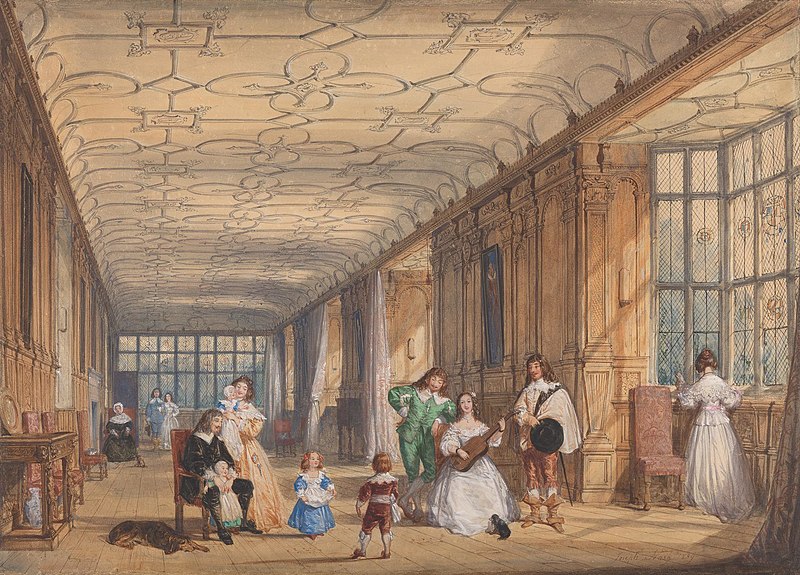Haddon Hall
![[Haddon Hall, steps, Derbyshire, England] [Haddon Hall, steps, Derbyshire, England]](https://tile.loc.gov/storage-services/service/pnp/ppmsc/08300/08315v.jpg#h=771&w=1024)

In Susanna White’s 2006 film adaptation of Jane Eyre, the on-screen depiction of Thornfield Hall can be found in Derbyshire, England near the town of Bakewell. This filming location is known as Haddon Hall, a private residence of Lord and Lady Edward Manners dating back to the twelfth century (“Discover”). Haddon Hall parallels well with Charlotte Brontë’s characterization of Thornfield Hall in many ways: both seem to carry unique features, an air of seclusion, and years of history pertaining to a particular family.
Haddon Hall is considered “one of the oldest houses in the country and moreover one of the only houses in England to have remained in one family’s ownership for its entire existence;” it remained untouched for nearly two hundred years from the 1700s, “allowing it to remain unaltered during the modernising period of the Georgians and Victorians” (“History”). Although Jane Eyre is set in the early 19th century, it can be assumed Thornfield Hall had been longstanding since it was an inheritance Mr. Rochester received upon the death of his father and brother. Especially with Mr. Rochester’s nature of leaving for long periods of time and rarely updating the residence, the presence of old relics and paintings from earlier periods could be easily imagined to resemble that of Haddon Hall. A visual example can be found in the paintings and furniture depicted in Bertha Mason’s room, presumed to be updated very little due to the nature of her stay (51:00-51:45). Furthermore, characters within the novel seem to perceive Thornfield as a place of aged history—Mrs. Fairfax describes it as “a fine old hall, rather neglected of late years perhaps, but still it is a respectable place” while Mr. Rochester himself claims he likes Thornfield and “its antiquity; its retirement” (89, 130).
Earlier in Brontë’s novel, Jane describes Thornfield as “a gentleman’s manor-house” that was three stories high with “battlements round the top” and hills farther off, “not so lofty… yet quiet and lonely hills enough” that painted Thornfield “with a seclusion [she] had not expected to find existent so near the stirring locality of Millcote” (91-92). Thornfield Hall seems to be given bleak, secluded, and gloomy descriptions throughout much of the novel, and White’s on-screen depiction embodies these characteristics inside Haddon Hall, relying much on candles, windows, and fireplaces for lighting (7:00-8:27). The outside, while secluded and similar in build, is brighter, blooming with flowers and surrounded in bright, green grass (23:26-24:02). Jane mentions Thornfield meadows, fields, and hedges full of roses as she returns from Gateshead, but the Elizabethan Walled Gardens of the film location seem to provide the perfect setting for Jane and Mr. Rochester’s long walks as well as a sense of contrast to what lies inside his home: his history and long-hidden secrets (219).
Susanna White was not alone in selecting Haddon Hall as the filming location for Thornfield Hall in her film adaptation of Jane Eyre. Directors Franco Zeffirelli and Cary Fukunaga were also appealed by the visual representation the location offered for their 1996 and 2011 films, and other high-profile productions such as Pride & Prejudice (2005) and The Princess Bride (1987) have been filmed here as well (“Film & TV”). Overall, White’s decision to film her adaptation of the novel at Haddon Hall may not be original or unique. However, it is telling of the significance placed on providing viewers with near-accurate depictions of the novel’s time period, interesting but fitting interpretations of Thornfield Hall, and thoughtfully fashioned depictions that serve as visual and emotional representations of the novel.
Works Cited
Brontë, Charlotte. Jane Eyre, edited by Deborah Lutz, 4th ed. Norton, 2016.
“Discover.” Haddon Hall, https://www.haddonhall.co.uk/discover/. Accessed 18 Mar. 2022.
“Films & TV.” Haddon Hall, https://www.haddonhall.co.uk/discover/films-tv/. Accessed 18 Mar. 2022.
Haddon Hall, steps, Derbyshire, England. Photograph. Retrieved from the Library of Congress, www.loc.gov/item/2002696685/. Accessed 19 Mar. 2022.
“History.” Haddon Hall, https://www.haddonhall.co.uk/discover/history/. Accessed 18 Mar. 2022.
“Jane Eyre: Episode 2.” Films On Demand, Films Media Group, 2006, fod.infobase.com/PortalPlaylists.aspx?wID=101269&xtid=128872. Accessed 18 Mar. 2022.
Nash, Joseph. The Long Gallery, Haddon Hall, Derbyshire. 1839. Wikimedia commons, https://commons.wikimedia.org/wiki/File:Joseph_Nash_-_The_Long_Gallery,_Haddon_Hall,_Derbyshire_-_B1975.3.1242_-_Yale_Center_for_British_Art.jpg. Accessed 19 Mar. 2022.
Coordinates
Longitude: -1.648442745045
